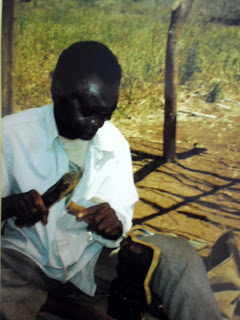
and wood hand saw for preparing the work pieces:

In Tanzania to cut down ebony tree is government control, you can not freely cut the tree, one has to have a permit and license to do so. Now coming back to our topic, the carvers frequently use the following tools: Makonde Chopping axe (tezo) for preparing the initial shape of the carving:

Hand file (Kurubula) for finishing work, on the carving:

Below we can see hand file application on finishing process of Giraffe by Mzee Kibange of Majengo Makonde carvers, Moshi, Kilimanjaro:
Makonde Wood scraper (Mkwango) for detailed finishing such as on the eye:

Makonde Wood scraper (Pondola) for finishing work:

Makonde Carving knife ( chipula):

Makonde Mallet ( Kiwenguwengu) it is used as a hammer whilst chiseling out the work piece:


In the past a carving was doned entirely by one carver and they used to sign engrave their names on the bottom stand of the carving or sometimes at the bottom end of the carving. Now with commercialization we have specialization. Some carvers do the initial rough piece of the carving, followed by those who specialised on detailed work and lastly by finishing experts. And that is why now you can rarely find a carving signed as it formerly was.















